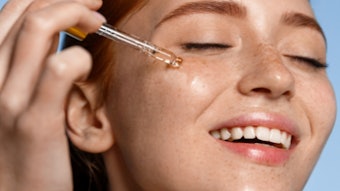
Anti-adhesion in relation to particulate matter, along with sebum oxidation, advances in sunscreens, plant extracts for oily skin and epicutaneous patch testing were the foci of BASF's research featured during the IFSCC 2018 Congress in Munich. Following are some highlights.
Anti-adhesion of Particulate Matter
Pollution can impart multiple negative effects to skin and hair. As such, there is no "one size fits all” approach to determining anti-pollution efficacy. Instead, Annette Mehling, Ph.D., and coresearchers at BASF followed the rationale that prohibiting particles from adhering to skin and hair in the first place could prevent negative effects.
The group designed a standardized test to assess the effects of various formulation constituents, such as polymers and emollients, to remove activated charcoal applied to the skin of human volunteers. Key to this test was the application route of particulate matter: via air, to emulate an in situ experience.
The systematic approach revealed clear differences in the adhesion and pollutant removability depending on the individual substances applied. These findings were then used to develop formulations to impart anti-adhesion and particulate removal effects without forfeiting moisturization or skin feel.
Pollution Synergy Oxidizes Sebum
According to Zhi Rao, Ph.D., and coauthors, preventing sebum oxidation is a growing consumer concern since it can be an initial phase of forming acne. As such, the oxidation of synthetic sebum—its squalene content, in particular—was assessed under simulated conditions. For example, various ingredients and formulations were applied to a sebum film and exposed in a city pollution chamber; their anti-pollution efficacy was then compared.
Squalene, a major component of sebum, is a double-bonded lipid molecule whose oxidation rate can be further accelerated by gases, UV irradiation and porphyrins produced by skin microflora. Its oxidation rate was found to increase with exhaust gas pollutant concentrations and UV irradiation time. In addition, when UV and exhaust gas were combined, the oxidation rate was enhanced further, indicating a synergistic effect between exhaust gas and UV irradiation.
The test results showed that sebum oxidation was not influenced by a single factor, but by the interactions of environmental factors. These findings provided evidence and clues for the further investigation of anti-pollution ingredients for skin and scalp care.
Molecular Aggregates in Sunscreens
Bernd Herzog, Ph.D., shared insights on molecular aggregates in sunscreens, as well as detecting spatial UV filter repartitions using confocal Raman microspectroscopy. Here, the sizes and shapes of aggregates, particles and liposomes were investigated. The liposomal aggregates showed a strong hypsochromic shift in the UV-absorption spectrum, compared with their dissolution in organic solvent. This property was used to study their water-resistance properties, which appeared enhanced compared with conventional UV absorbers.
Another type of aggregate is particulate organic UV absorbers. Although these scatter light, their main protective effect is due to absorption. In contrast to the liposome-forming UV-absorbers, their UV spectrum is shifted to longer wavelengths. This feature is advantageous for improving the broad-spectrum protective properties of sunscreens.
In general, it was shown that particle sizes of organic and inorganic particulate UV absorbers, in terms of number size distribution, should be in a range below 100 nm to show efficient UV protective properties.
Plant Extract to Mattify Shine and More
Valérie Andre-Frei, Ph.D., leveraged BASF's 3D model of sebaceous glands to develop an ingredient to care for oily skin. Oily skin is a global concern; its inherent shine emphasizes enlarged pores and skin imperfections. This condition is linked to hyperactive sebaceous glands.
First, plant extracts (details not disclosed) were screened on human sebocytes to confirm activity. The optimized solution was then tested in a 3D human ex vivo sebaceous gland model that maintains the structure and capacity of the gland to produce physiological sebum, as previously demonstrated. Furthermore, since oily skin can lead to acne when Propionibacterium acnes is highly present, the effects of the plant extract on P. acnes lipase activity were assessed.
The plant extract reduced P. acnes lipase activity by 31%. It also protected skin from inflammatory free fatty acids generated by triglycerides. In a two-month clinical study of 35 Asian women (ages 20-45 years old) presenting with oily skin, the plant extract at 0.25% significantly reduced the number of active sebaceous glands by 20% after 28 days, versus a placebo. A reduction in pore sizes on the cheeks also was observed after 56 days (clinical scoring). Finally, skin moisturization was preserved (corneometer versus D0), and participants observed matte skin effects.
Epicutaneous Patch Testing Tweaks
Finally, Mehling also presented on epicutaneous patch testing, which while routinely used as a method to screen for the compatibility of cosmetic formulas, is limited in its capability to assess reactions. In conjunction with the DGK work group, the team found that simple modifications to existing test protocols provided important insights about immediate skin reactions.
For example, an occlusive, short-term patch test protocol with evaluations taken after 10 min and 30 min was developed, which successfully identified spontaneous reactions. It also drew a correlation between the intensity of reactions observed in the short-term test and those observed in controlled in-use studies.
The authors concluded short-term patch testing via the described protocol could be used as a reliable screening method toward the development of non-irritating cosmetic formulas. The authors note the lessons learned from this study indicate simple modifications of existing test protocols can lead to important insights into skin reactions.










